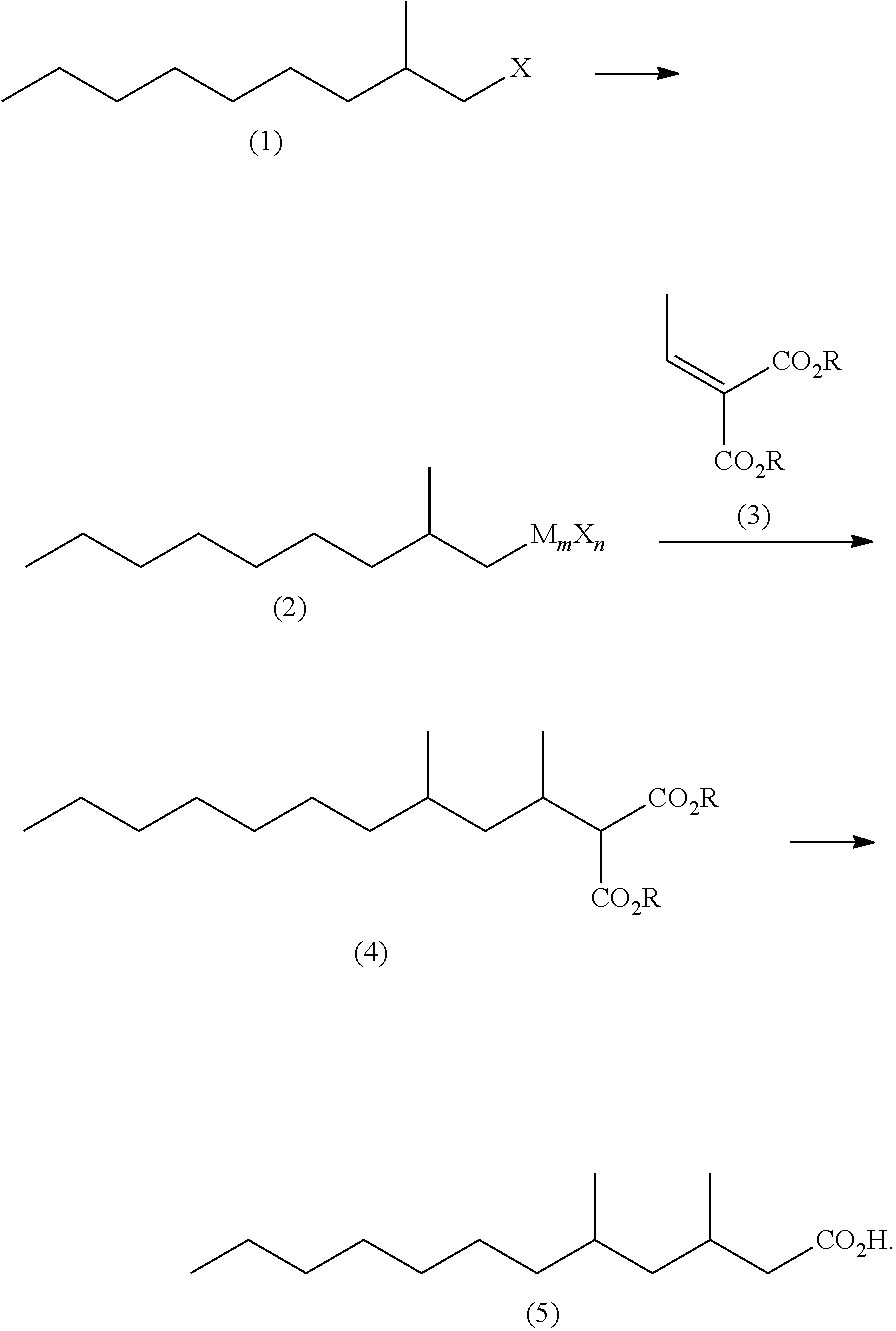Method for producing 3,5-dimethyldodecanoic acid
a technology of dimethyldodecanoic acid and 3,5-dimethyldodecanoic acid, which is applied in the preparation of carboxylic acid esters/lactones, chemistry apparatus and processes, and organic chemistry, etc. it can solve the problems of not easily available industrially, the method is far from an industrial synthesis method, and it is difficult to industrially produce a sufficient amount of 3,5-dimethyldodecanoic acid, etc., to achieve the effect of simple and efficien
- Summary
- Abstract
- Description
- Claims
- Application Information
AI Technical Summary
Benefits of technology
Problems solved by technology
Method used
Image
Examples
example 1-1
Production of ethyl 2-(1,3-dimethyldecyl)malonate (4Et)
(Example in which Each of Two Rs Represents an Ethyl Group)
[0085]In a nitrogen atmosphere, magnesium (3.17 g, 0.131 mol) and tetrahydrofuran (37 g) were placed in a reaction vessel and stirred at from 60 to 65° C. for 30 minutes. Then, 2-methylnonyl chloride (1Cl) (21.9 g, 0.124 mol) was added dropwise thereto, and stirred at from 70 to 75° C. for 2 hours to produce 2-methylnonyl magnesium chloride (2MgCl).
[0086]In a nitrogen atmosphere, cuprous chloride (0.30 g, 0.0030 mol), tetrahydrofuran (68 g) and triethyl phosphite (0.90 g, 0.0078 mol) were placed in another reactor, and then cooled to −10° C. to 0° C. with stirring. Then, a solution of ethyl 2-ethylidene malonate (3Et) (22.0 g, 0.118 mol) in tetrahydrofuran (68 g) was added thereto, and then the above produced 2-methylnonylmagnesium chloride solution was added dropwise thereto at −10° C. to 0° C. The reaction mixture was stirred at Q to 10° C. for one hour. A mixture of a...
example 1-2
Production of methyl 2-(1,3-dimethyldecyl)malonate (4Me)
(Example in which Each of Two Rs Represents a Methyl Group)
[0090]In the same manner as in Example 1-1 except that methyl 2-ethylidene malonate (3Me) (18.7 g, 0.118 mol) was used in the place of ethyl 2-ethylidene malonate (3Et) (22.0 g, 0.118 mol), a crude product (43.4 g, 0.0859 mol) of methyl 2-(1,3-dimethyldecyl)malonate (4Me) was obtained. The yield was 69%.
example 1-3
Production of ethyl 2-(1,3-dimethyldecyl)malonate (4Me)
(Room Temperature Reaction, and Dropwise Addition of Ethylidene Malonate to Grignard reagent).
[0091]In a nitrogen atmosphere, magnesium (3.52 g, 0.145 mol) and tetrahydrofuran (41 g) were placed in a reaction vessel and stirred at from 60 to 65° C. for 30 minutes. Then, 2-methylnonyl chloride (1 Cl) (24.4 g, 0.138 mol) was added dropwise thereto, and stirred at from 70 to 75° C. for 2 hours to produce 2-methylnonylmagnesium chloride (2MgCl).
[0092]The above reaction mixture was cooled to 20° C. and subjected to addition of cuprous chloride (0.34 g, 0.0035 mol), tetrahydrofuran (127 g) and triethyl phosphite (1.00 g, 0.0086 mol). Then, a solution of ethyl 2-ethylidene malonate (3Et) (24.4 g, 0.131 mol) in tetrahydrofuran (25 g) was added dropwise thereto at from 20° to 30° C. and the resulting mixture was stirred at from 20° C. to 30° C. for one hour. A mixture of ammonium chloride (6.5 g), 20% by weight hydrochloric acid (22 g) a...
PUM
| Property | Measurement | Unit |
|---|---|---|
| molar ratio | aaaaa | aaaaa |
| reaction time | aaaaa | aaaaa |
| reaction temperature | aaaaa | aaaaa |
Abstract
Description
Claims
Application Information
 Login to View More
Login to View More - R&D
- Intellectual Property
- Life Sciences
- Materials
- Tech Scout
- Unparalleled Data Quality
- Higher Quality Content
- 60% Fewer Hallucinations
Browse by: Latest US Patents, China's latest patents, Technical Efficacy Thesaurus, Application Domain, Technology Topic, Popular Technical Reports.
© 2025 PatSnap. All rights reserved.Legal|Privacy policy|Modern Slavery Act Transparency Statement|Sitemap|About US| Contact US: help@patsnap.com



